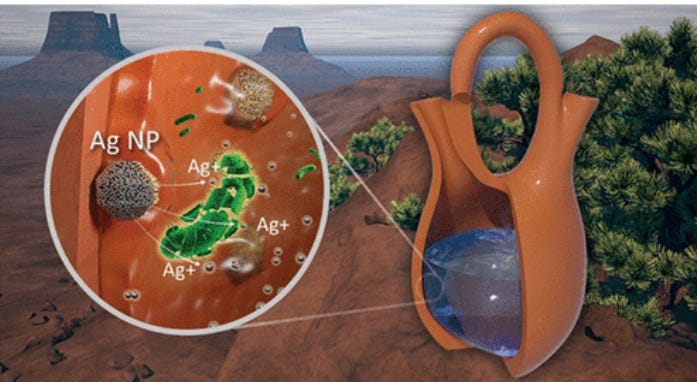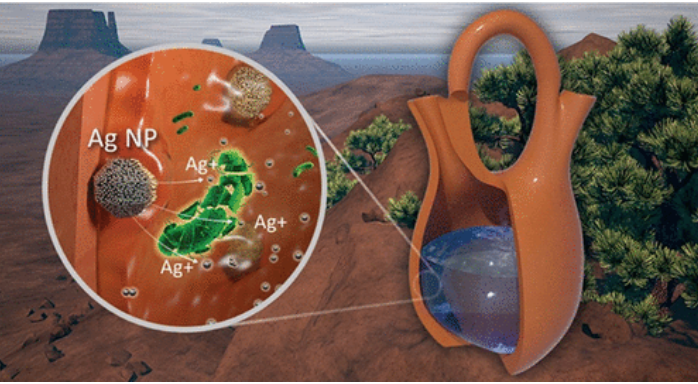
Ship Rock is called Tsé Bitʼaʼí in Navajo, which means “rock with wings” or simply “winged rock.” The formation figures prominently in Navajo Indian mythology as a giant bird that carried the Navajo from the cold northlands to the Four Corners region
Jon Forrest Little reports that The Silver Academy got the call this morning to work with the Diné and over 35 of the 110 Navajo Chapters for a water purification pilot project on The Navajo Reservation.
This pilot project will then launch technology transfer towards all First Nation lands and the Developing World.
“Lining clay pots with pine tree resin collected from Navajo Nation (Four Corners Region) plus Silver particles to purify water.“
Backstory
My first job reporting was covering football and basketball games on the Navajo Reservation. The games were in Shiprock, Newcomb, Thoreau (near Crownpoint), New Mexico, and Window Rock, Arizona, all across the Navajo Nation and Monument Valley on the most extensive Indigenous lands in the USA.
When I covered the football games for small papers in the 4 corners area, the known warning was to avoid drinking the water, so I always had a canteen full of water to bring along with my yellow #2 pencils, yellow legal tablet & 35 mm camera.
Funny story: my grandmother Louise Dickinson was a teacher on tribal lands. On her first day teaching, the students tricked her into getting some school supplies out of a storage closet, then locked her in the closet as her initiation.
My grandfather Herb Clifton Dickinson was one of only 3 Anglos at Shiprock High (his father worked for the Bureau of Land Management), and he was given the Navajo name Hastiin Ajéí, meaning (Mr. Kind heart) for his bravery and hanging in there as a minority when tensions and frictions were understandably high.
Silver Particles: Purifying Water on the Navajo Nation
Large swaths of the Navajo Nation in the Southwest lack access to clean drinkable water, a trend that has been rising in many parts of the U.S. in recent years. A research team led by engineers with The University of Texas at Austin aims to change that.
The team has developed a new water filtration solution for members of the Navajo Nation, lining clay pots with Piñon tree resin collected from the Navajo Nation and incorporating tiny, silver-based particles that can be used to purify water to make it drinkable.

“Making water filtration technology cheap doesn’t solve all the problems, and making it effective doesn’t solve everything either,” said Navid Saleh, a professor in the Fariborz Maseeh Department of Civil, Architectural and Environmental Engineering and one of the leaders on the project. “You have to think about the people you are making it for.”
And that’s what the researchers did. They worked closely with a third-generation potter from Arizona — Deanna Tso, who is also a co-author on the paper — to create a device that is simple for the users. All they have to do is pour water through the clay pots, and the coated pottery removes bacteria from water and generates clean, drinkable water.
The Navajo Nation has a history of mistrust of outsiders, the researchers say, and that makes it less likely that people there would adopt a new technology made entirely by others. Using pottery, working with the community, and relying on local materials were important to the effectiveness of this project.
The research appears in a new paper in the journal Environmental Science & Technology.
“Navajo pottery is at the heart of this innovation because we hoped it would bridge a trust gap,” said Lewis Stetson Rowles III, now a faculty member at Georgia Southern University’s Department of Civil Engineering and Construction after earning a Ph.D. from UT in 2021. “Pottery is sacred there, and using their materials and their techniques could help them get more comfortable with embracing new solutions.”
Using silver particles for water filtration is not the main innovation. Others have used this technology in the past. The key is controlling the release of nanoparticles, which can reduce the usable life of the filters. And the silver particles mix at high volume with some of the chemicals, such as chloride and sulfide, in the untreated water, leading to a “poison layer” that can reduce the disinfection efficacy of the silver particles on the clay lining.
The researchers used materials abundant in the environment of the community, including pine tree resin, to mitigate the uncontrolled release of silver particles during the water purifying process. The materials and construction process for the pots cost less than $10, making for a potentially low-cost solution.
“This is just the beginning of trying to solve a local problem for a specific group of people,” Saleh said. “But the technical breakthrough we’ve made can be used all over the world to help other communities.”
This research dates back to close to 10 years. The original idea for this project was sketched out on a Subway napkin and refined over many trips to those communities, experiments, and iterations. Rowles himself has pottery skills, and a desire to work on this issue of a lack of drinking water in native communities.
The next step for the researchers is to grow the technology and find other materials and techniques to help communities use the materials abundant in their regions to help create fresh, drinkable water. The researchers are not seeking to commercialize the research, but they are eager to share it with potential partners.
Other team members on the project include Desmond Lawler, a professor emeritus, who was Rowles’ co-adviser; civil, architectural and environmental engineering professor Mary Jo Kirisits; and Andrei Dolocan, a senior research scientist at the Texas Materials Institute.
Abstract from – https://pubs.acs.org/doi/full/10.1021/acs.est.3c03462#
Point-of-use treatment technologies can increase access to safe drinking water in rural areas. Sustained use of these technologies is uncommon due to oversight of community needs, user-perceived risks, long-term maintenance, and conflict with traditional practices.
Nanosilver-enabled ceramic water filters are unique due to the use of locally sourced materials available at or near the target community; however, technical limitations persist (e.g., nanosilver’s uncontrolled release and passivation from sulfide or chloride). This work aims to overcome these limitations by impregnating nanosilver onto ceramics with a Navajo pottery rosin, collected from pinyon trees with a third-generation artisan. Here, we investigate this sustainable and novel material for drinking water treatment; the study ranges from a proof of concept to testing under realistic conditions.
Results show that when embedded in a thin film, the biopolymer controlled ionic silver dissolution and prevented silver passivation from sulfide and chloride. When applied to ceramic filters, the biopolymer effectively immobilized nanosilver in a range of waters. Over a 25 day study to emulate household-use conditions, this coating method sustained disinfection of a coculture of Gram-positive and Gram-negative bacteria while controlling biofouling. Overall, the use of this Navajo pottery material can facilitate adoption while providing the needed technological advancement to these widely used treatment devices.

